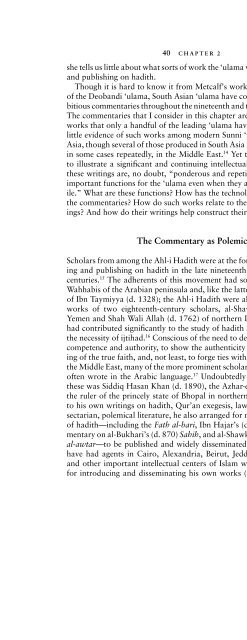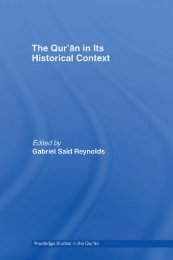Download (1 MB) - Islam and Christian-Muslim Relations: Articles ...
Download (1 MB) - Islam and Christian-Muslim Relations: Articles ...
Download (1 MB) - Islam and Christian-Muslim Relations: Articles ...
Create successful ePaper yourself
Turn your PDF publications into a flip-book with our unique Google optimized e-Paper software.
40 CHAPTER 2she tells us little about what sorts of work the ‘ulama were actuallywriting<strong>and</strong> publishing on hadith.Though it is hard to know it from Metcalf’s work on the earlyhistoryof the Deob<strong>and</strong>i ‘ulama, South Asian ‘ulama have continued to write ambitiouscommentaries throughout the nineteenth <strong>and</strong> twentieth centuries. 13The commentaries that I consider in this chapter are the sort of “elitist”works that onlya h<strong>and</strong>ful of the leading ‘ulama have produced. There islittle evidence of such works among modern Sunni ‘ulama outside SouthAsia, though several of those produced in South Asia have been published,in some cases repeatedly, in the Middle East. 14 Yet these writings sufficeto illustrate a significant <strong>and</strong> continuing intellectual tradition. Manyofthese writings are, no doubt, “ponderous <strong>and</strong> repetitive,” but theyserveimportant functions for the ‘ulama even when theyappear to us as “sterile.”What are these functions? How has the technologyof print affectedthe commentaries? How do such works relate to the ‘ulama’s other writings?And how do their writings help construct their religious authority?The Commentary as PolemicScholars from among the Ahl-i Hadith were at the forefront of those writing<strong>and</strong> publishing on hadith in the late nineteenth <strong>and</strong> earlytwentiethcenturies. 15 The adherents of this movement had some affinitywith theWahhabis of the Arabian peninsula <strong>and</strong>, like the latter, admired the workof Ibn Taymiyya (d. 1328); the Ahl-i Hadith were also influenced by theworks of two eighteenth-centuryscholars, al-Shawkani (d. 1839) ofYemen <strong>and</strong> Shah Wali Allah (d. 1762) of northern India, both of whomhad contributed significantlyto the studyof hadith <strong>and</strong> had emphasizedthe necessityof ijtihad. 16 Conscious of the need to demonstrate their owncompetence <strong>and</strong> authority, to show the authenticity of their underst<strong>and</strong>ingof the true faith, <strong>and</strong>, not least, to forge ties with religious scholars ofthe Middle East, manyof the more prominent scholars of the Ahl-i Hadithoften wrote in the Arabic language. 17 Undoubtedlythe most prolific ofthese was Siddiq Hasan Khan (d. 1890), the Azhar-educated husb<strong>and</strong> ofthe ruler of the princelystate of Bhopal in northern India. 18 In additionto his own writings on hadith, Qur’an exegesis, law, <strong>and</strong> a vast bodyofsectarian, polemical literature, he also arranged for manyclassical worksof hadith—including the Fath al-bari, Ibn Hajar’s (d. 1449) classic commentaryonal-Bukhari’s (d. 870) Sahih, <strong>and</strong> al-Shawkani’s (d. 1839) Naylal-awtar—to be published <strong>and</strong> widelydisseminated. 19 He is reported tohave had agents in Cairo, Alex<strong>and</strong>ria, Beirut, Jeddah, Constantinople,<strong>and</strong> other important intellectual centers of <strong>Islam</strong> who were responsiblefor introducing <strong>and</strong> disseminating his own works (<strong>and</strong> those published



